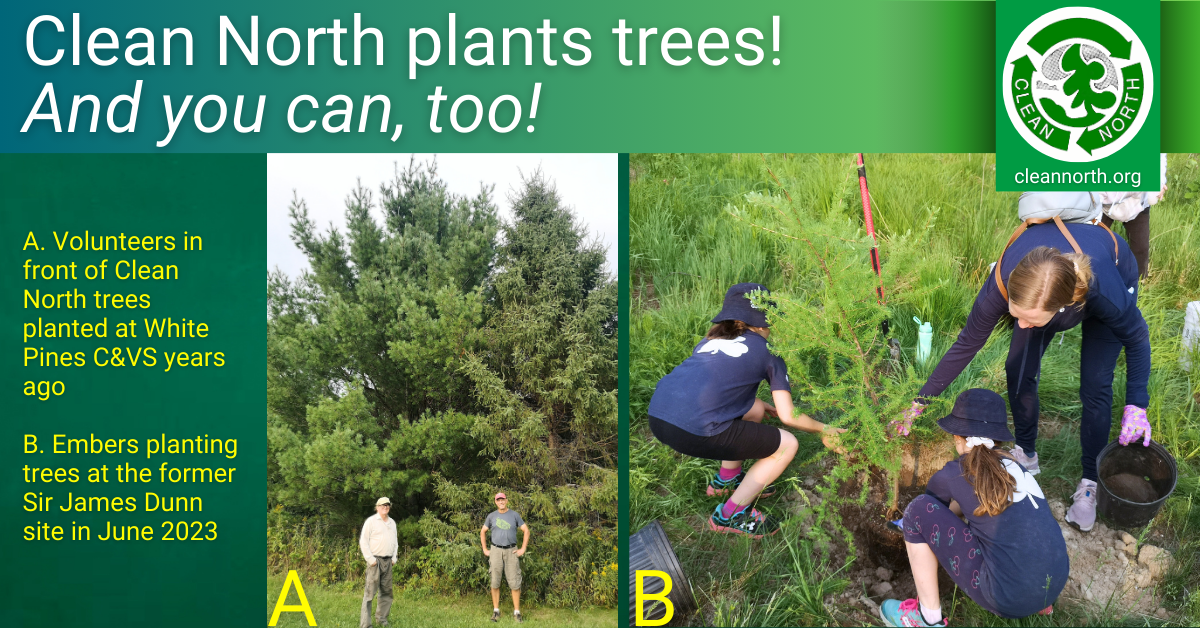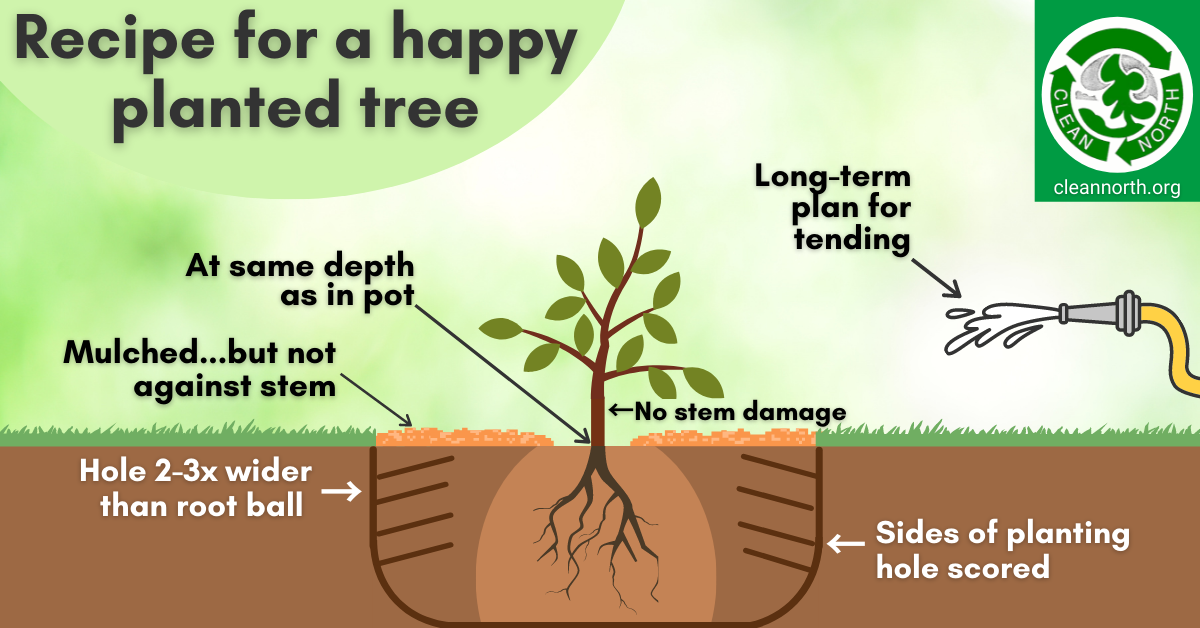
Did you know that Clean North has planted thousands of trees all across the City of Sault Ste. Marie? “Planting trees has been part of Clean North’s mission for 30 years,” says volunteer Don McGorman. “We see urban tree planting as a high-value environmental activity for several reasons, including that trees help keep our cities cooler in summer, provide important habitat for urban wildlife and insects, and help fight climate change by taking in carbon as they grow.”
Urban tree cover has even been associated with reduced crime rates (read more).
Our largest tree planting project at the moment is happening in the east end, between the community garden at Emmaus Anglican Church and the site where Sir James Dunn Collegiate and Vocational School stood. With the help of many volunteers, dozens of aspen, white birch, red oak, white pine, tamarack, and other species have been planted over the past five years. There’s even a black walnut tree—a rare species for this locale.
“When you are planting trees in an urban landscape, it’s wise to plant more than one species,” says Clean North chair Bill Cole, a retired forest research scientist. “A diverse forest has more resilience to stressors like pests and disease. If you plant only oaks and an oak disease comes through, you can lose every tree, and bingo, your patch of woods is gone. By planting multiple species in this plantation, we are reducing the risk of losing all the trees at one time. Planting a variety of species also better supports biodiversity and tends to be more aesthetically pleasing.”
Since the site is next to the community garden at Emmaus Anglican Church, where Clean North has a vegetable bed and access to water, volunteers can more easily water newly planted trees—a job that just keeps getting more important as climate change gives us hotter, dryer summers.
Read how Clean North provided cedar trees for the new withdrawal management facility in the Sault!
Creating a pollinator paradise
In its previous life as a high school, the plantation site was maintained as a lawn. With Clean North planting trees along the patch of bush at the north east end of the site, no mowing is happening among the trees, and it’s loaded with flowering plants and lots of pollinators and birds. Volunteers have been removing some of the invasive plants on site and planting some native species, and they are hoping to add more native wildflowers in the future.
Think you want to plant trees? What you need to know….
We at Clean North have seen well-meaning community tree planting efforts fail time and time again. For example: A plantation of 500 trees with not a single tree left alive after five years! How does this happen?
- Unsuitable site: Tree species are not well matched to the site—the soil is:
- Too sandy or too clay-ey
- Too dry or too wet
- Too shady or too open (some species actually prefer a bit of shade when young)
- Poor planting practices:
- The planting hole is too small to allow roots to grow.
- Trees are planted too deep or not deep enough.
- Tree stems are damaged by shovels during planting.
- Mulch is piled against the stem after planting.
- Competition: Wildflowers, shrubs, and grasses growing around the trees may divert nutrients and moisture or cast shade.
- Neglect: Trees are often planted, maybe looked after for a season or two, then forgotten. Small trees that experience repeated periods of extreme heat/moisture stress can die quickly.
- Damage: Schoolyards are popular locations for tree planting, but it is common for young schoolyard trees to die quickly due to being repeatedly whacked by mowers/string trimmers or vandalized.
- Predators: Many critters (caterpillars/other insects, rodents, deer, rabbits) love to eat young trees.
- Diseases: Young, newly planted trees can be especially vulnerable to tree diseases. For example, young white pines growing in the open are prone to blister rust, an often-fatal disease caused by an invasive fungus.
Bottom line: Trees are like children. They require protection and a long-term commitment. Have a plan to sustain them over the long haul.
Planning tree planting
Questions to ask yourself/your tree planting crew as you make a tree planting plan:
- What species are we interested in planting? (Please check to make sure they are not invasive—avoid Manitoba maple, Norway maple, tree of heaven, autumn olive, common/glossy buckthorn, and black locust.)
- What’s the soil on our site like—sand, loam, clay; acidic or alkaline?
- How dry/wet is the site?
- Is it shaded, partly shaded, or open?
- Do we want a fast-growing tree for quick shade (tend to be shorter lived) or a slow grower that lives longer?
- Are there any overhead or buried lines or water/sewer pipes (always get a utility line locate before planting), existing large trees/shrubs, or other obstacles to planting/growth?
- How close is my desired planting place to my home or garage or other structures?
- If I wish to plant a conifer tree, how wide does it get? Will it fit in the location once full grown?
- Is my tree species of choice likely to drop branches or a lot of seed or will it result in many undesired seedlings coming up all over my yard? (Maple is famous for this.)
- Do I need permission to plant at my chosen site?
- Who needs to be made aware of newly planted trees to prevent issues like mower/strong trimmer damage?
- What time of year is best to plant the species I chose?
- Who/how will provide care over time—keep the tree(s) watered, control the weeds, and protect the stem(s) from mowers/weed trimmers over the long term (at least 5-10 years)?
How to plant trees
When to plant
It’s possible to plant a tree at any time during the growing season. However, if you are unable to provide constant care, planting in early spring or fall is much better. The obvious advantage is reduced risk of extreme heat and moisture stress. However, trees planted in fall can die, too, especially if they go into winter with dry roots.
Choosing site and species
- Choose your planting location carefully. Make sure the species you’ve chosen is/are suited to the soil type and pH, water is available, and trees have room to grow to their expected mature size above and on all sides without creating issues.
- Avoid planting trees so close together that they eventually stunt each other’s growth.
- Choose tree species carefully to make sure they work for your objectives (aesthetics, shade, habitat, privacy, etc.).
- Keep in mind that native species are better adapted to our conditions, with trees grown from local seed being optimal. Also, some non-native species do not support our birds and insects. Norway maple, for example, is an ecological desert. Birds fly into these trees and then fly right out again because there’s nothing for them to eat in there. And it’s an invasive species!
- Be cautious about what species you plant close to a house, garage, driveway, sidewalk, or other structures and observe where trees will cast shade once mature. For example, plant weeping willows well away from foundations and water/sewer lines, and keep in mind that mature tree roots can create large humps in asphalt driveways.
- Make sure you have permission to plant on the chosen site and notify all relevant people (for example, grounds crews at a school/institution/office building).
- Get a utility line locate before digging!
On tree planting day
When preparing to plant, wear proper safety equipment (work gloves, closed-toe shoes, safety or sunglasses, etc.) and assemble all equipment, including water.

Planting trees
- Dig a hole 2-3 times wider than the tree’s root ball. Slash the sides and bottom of the hole to help roots penetrate the surrounding soil.
- Plant each tree so the soil line hits the stem at the same place where the soil in the pot did.
- Fill in the rest of the hole with soil. You can use soil from the hole or better yet, soil mixed with compost.
- Watch your shovel! Avoid whacking the tree stem while returning soil to the hole.
- Gently pack down the soil around the tree and add more soil as needed. Use your hand to pat down the soil around the tree roots; with the foot, it’s easy to compact the soil too much.
- Water the tree well.
- If the soil settles more after watering, add more soil as needed to ensure the base of the stem is planted at the same level as the surrounding soil (strive for level rather than a mound or depression).
- Form a small ridge around the edge of where you dug the hole to stop water flowing away from the roots.
- Ideally, apply mulch 2-4 inches deep in a doughnut shape around the tree. Do not pile mulch right up against the stem! Make the mulch ring at least as wide as the tree crown to help control weeds and conserve soil moisture.
After care
- Keep freshly planted trees well watered for at least a week after planting. Then water slowly and deeply once a week during dry spells.
- Avoid fertilizing the first year.
- Avoid staking unless the planting site gets strong winds or the soil is shallow. Avoid staking for more than a year to reduce risk of bark damage from the staking rope.
- Read up on how and when to prune each species you are planting to ensure optimal form and a strong, healthy tree. Never prune an oak tree in spring or summer to reduce risk of oak wilt disease.
- Prevent injuries to the tree stem or foliage from lawn tools, children, pets, etc. For example, string trimmer damage is a common cause of death for young yard trees, and dog pee can kill young trees through ammonia toxicity.
- Ensure long-term care. If you are sidelined, who will look after the tree(s) in a year, five years, 10 years?
Questions about planting trees?
Contact us at info@cleannorth.org.




